Forum Hadriani (Voorburg)
Q2586986Forum Hadriani: small town in the Roman province of Germania Inferior, modern Voorburg near The Hague in Holland.
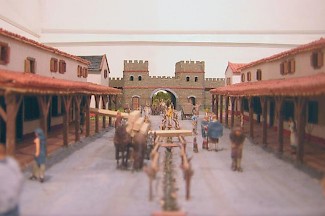
The Roman town, which may have been founded immediately after the Batavian revolt of 69-70, was originally called Municipium Cananefatium, "the town of the Cananefates". This name can be found, for example, on the milestones discovered in The Hague. The town was the capital of this tribe, which was probably related to the Batavians and lived in what is now the Dutch province of Zuid-Holland.
The town was founded at exactly the watershed between the basins of northern and southern branch of the river Rhine. It is possible that it originally was the site where ships were hauled from one little brook to another. After 47, a canal was dug by the Roman general Gnaeus Domitius Corbulo.
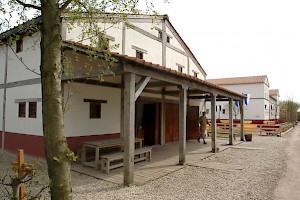
In the second century, the town of the Cananefates received the title of Forum Hadriani. Too much has been made of this new name, which simply means "market of Hadrian". It was not uncommon for towns to change their name to honor a ruler. Several archaeologists have claimed that the emperor Hadrian (117-138) awarded the right to organize markets to the town, which can therefore, in their view, best be typified as a market town. However, we know enough of Roman Law to understand that as a municipal capital, Voorburg did already have this prerogative. The fact that the old name was still in use during the reign of the emperor Decius (249-251), should have been sufficient warning against this theory.note

The only thing we know for certain is that the town changed its name. It is tempting to link this to several well-documented building activities in the region during the reign of Hadrian (e.g., repairs of the Canal of Corbulo, which connected Voorburg with the Rhine at Leiden in the north and the estuary of the Meuse in the south).
Many rooftile stamps with the sign EXGERINF, Exercitus Germaniae Inferioris, attest to building activity by the army of Germania Inferior, the Roman province along the Lower Rhine. It consisted of the First legion Minervia (from Bonna) and the Thirtieth Ulpia Victrix (from Xanten). Because there were also rooftiles with the sign of the Classis Germanica Pia Fidelis, "the loyal and steadfast fleet of the German provinces", it was argued that Voorburg was once a naval station like Köln-Alteburg.
Remains of the Roman town have been excavated in park Arentsburg in modern Voorburg. It seems that the ancient settlement was, in spite of its small size (about a thousand inhabitants), a regular city with the common Roman gridiron lay-out and normal buildings like a bathhouse. Several houses had shops in front and gardens in the back. Parts of the river port were identified in 2007.
 Voorburg, Reconstruction of a kiln |
 Sherd, signed "Ianuarius" |
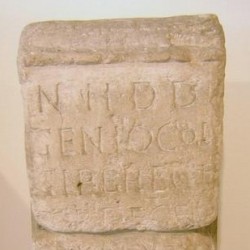 Voorburg, Dedication by Ulpius December and Verecundus Cornutus |
 Voorburg, Samian ware |
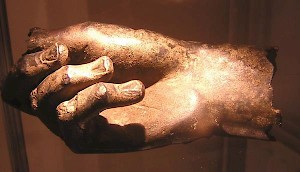
Archaeologists have established that the inhabitants left the town after c.270. This is more or less at the time of the disaster that befell Germania Inferior in 274, when the Roman emperor Aurelian reconquered northwestern Europe, which had become independent in 260 and had succeeded in defending itself against the Germanic Franks and Alamanni.
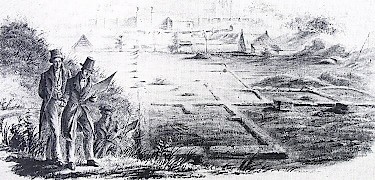
The collapse of this Gallic Empire meant the end of both the Rhine frontier and Roman Voorburg. The countryside suffered as well; the farm at Rijswijk - De Bult was abandoned too. When the frontier was restored by Constantius I Chlorus at the beginning of the fourth century, Forum Hadriani was not rebuilt. So, the end of the Roman city can be dated to about 275.
The site was excavated for the first time in 1827-1834 by Caspar Reuvens, the world's first professor of archaeology. At that time, the name Forum Hadriani was already known from the Peutinger map, and Reuvens was not certain about the interpretation of his discoveries. He cannot be blamed. After Pompeii and Herculaneum, it was the first systematic scientific excavation of a Roman civil settlement, and the results are even more impressive when we take into account that Reuvens' budget was cut back in 1830 because of war circumstances. It was only in the 1960s that J.E. Bogaers understood this important site.
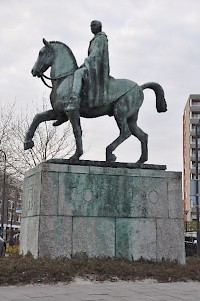
There is not much in modern Voorburg to remind the visitor that it is one of the oldest cities in the Nederlands. It is not possible to excavate the remains because they are on the UNESCO list of world heritage. However, there is this modern statue of Domitius Corbulo, the Roman governor of Germania Inferior, who, in the late forties of the first century, ordered a canal to be dug between the capital of the Cananefates and Matilo (modern Leiden).



